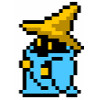Kaeru no Tame ni Kane wa Naru (unofficially translated as “For the Frog the Bell Tolls”) is best known not for itself but for being the spiritual predecessor to Link’s Awakening. Large parts of For the Frog’s engine were toadly reused and many of the features found in Link’s Awakening have a primitive form here. For this—and given the popularity of Link’s Awakening—For the Frog the Bell Tolls is usually talked about only in how it relates to its bigger cousin.
This doesn’t do the frog justice.
For the Frog the Bell Tolls is hopping with clever ideas that are not found in any other game. It was carefully crafted around a very specific theme for a specific device, and it manages to pull off an experience that is unique and able to stand out on its own, beyond Link’s windfish-sized shadow.
The title refers to the novel For Whom the Bell Tolls, by Ernest Hemingway—a dark and brutal novel that takes place during the brutal Spanish Civil War. Hemingway’s novel is named after meditation by John Donne, the famous “never send to know for whom the bell tolls; It tolls for thee.” Except, instead of whom, it’s the frog. The Frog.
Being more of brûlée than brutality, Kaeru no Tame ni Kane wa Naru’s dessert-themed world is an eclair of a game overfilled with delicious absurdity. The hero is the Prince of Sablé (a french shortbread cookie). He and Prince Richard of the Custard Kingdom have a friendly rivalry until King Delarin kidnaps Princess Tiramisu of the Mille-Feuille Kingdom to try and force her hand in marriage. Both princes wanting to play the hero, they froget their friendship and hop off to do hero stuff.
The princes, as well as their company, are then turned into frogs by an obviously trustworthy witch, preempting the game’s title and its main gameplay mechanic. It turns out that Delarian is an evil snake who also eats frogs, and only the Prince of Sablé is able to transfrog back to his human form. As the game progresses, he’ll also gain the ability to turn into a snake. The story takes some truly goofy turns at places. At one point, the Prince needs to find wasabi for some sushi to make friends with a famous inventor at the game company Nantendo.
Transforming between frog, snake, and human forms are key components of the game’s puzzles, and Kaeru no Tame ni Kane wa Naru is built entirely around puzzles to the exclusion of all else. The entire world is essentially one large puzzle, with a very linear progression as you gain new abilities or items that unlock new paths. In the affrogmentioned frog form, the Prince will jump higher, swim through water, and eat bug-type enemies to restore health but cannot fight any enemies and will make snakes more aggressive. The prince cannot fight in snake form either, and also loses the ability to jump, but he can slither through narrow openings and can ambush weak enemies and turn them into blocks.


Only his human form can fight enemies, and it is these battles that are unlike anything in most other games. When he touches an enemy, the Prince and the foe will vanish into a cartoon-like cloud of dust, taking turns whittling down each other’s health. This is completely automatic, involves no player input, and the results are essentially pre-determined. The player can press B during a fight to pause and potentially use a special item or run away, but these actions typically only work on normal enemies, not bosses.
Combat is not something that the player can grind past but rather part of Kaeru no Tame ni Kane wa Naru’s puzzle world. You will either win a fight or lose it, and you will get the same result every time. Due to its linearity, the player’s current strength and item rollout is a known factor and battles are designed around that. For example, you may encounter a boss guarding a door that must be passed to move forward. Attacking the boss will never work because it has 3 hearts and you have two and it will always defeat you. When this happens, there is an item such as a power stone that increases attack nearby that the player needs to find to defeat the foe.


Combat is automatic with predetermined results.
While this may sound like it would get old before you finished reading the last paragraph, there’s enough variation that a fight is never quite boring. Early on, for example, you might find a saw to defeat a tree enemy blocking your path. Later, this is a millipede-like bug that you need to engage by attacking its tail first. Just like solving a block-puzzle, fights are another puzzle and they feel naturally at home here.
In addition to finding ways through (or around) combat encounters, many other puzzles are based on the Prince’s ability to change into the affrogmentioned snake and frog and to take advantage of their special abilities. The Prince has some control of changing between these forms. Turning into a snake or turning into a human requires a consumable item (which is readily available); hopping to frog form requires the Prince to touch water. To solve each puzzle means understanding the mechanics of each form and figuring out how and when to switch between them effectively. This is especially true when in the frog and snake forms since initiating combat as either is often death.
Despite having a variety of environments and feeling quite large, the world of Kaeru no Tame ni Kane wa Naru is very compact. Its desert, ice cavern, lake, island, and mountain all interconnect in ways that make you feel like it’s a much grander place than it is, a necessary illusion due to the Gameboy’s storage limitations. Every screen has its purpose. A narratively integrated map and diary—which cleverly acts as both a hint system and a save feature—ensure that the player will rarely get lost.


The in-game map and diary are integrated into the story. The diary a provides a summary of the story and hints, and also let's you save the game.
The overworld and towns are shown with a three-quarter top-down perspective. For dungeons and the castle—a central dungeon that will need to be visited multiple times to complete the game—the perspective is switched to the side with some basic platforming elements. These two perspectives are consistently used and as the player switches between them, the shift feels transparent and natural. Other games have tried similar gimmicks, but here it is done so well that sometimes you may not even notice the change.


For the Frog frequently shifts perspective, with the side-view used more frequently in dungeons.
Kaeru no Tame ni Kane wa Naru was never officially translated, but the fan localization is fantastic. The tone in dialogue matches the ribbeting style and subject of the game, not missing subtle nuances like the in-game company named Nantendo or aptly named frogslator that lets you talk to frogs in human form. While never serious but still very text-heavy, there are no awkward misspellings or poorly localized strings bringing the story to halt, a credit to the skill that went into it.
Taking only about five hours to complete, For the Frog feels like the perfect length. The adventure lasts long enough that you feel like you’ve explored every aspect its unique mechanics can offer without feeling padded or overstaying its welcome. It’s an absolute joy to play, and while there aren’t any extras, sequence breaking, or other motivation for repeated playthroughs, it doesn’t need those things to achieve its goal of light-hearted puzzle adventure.
There’s more than just a passing connection to Link’s Awakening here. In addition to repurposing its engine, many parts of Link’s Awakening’s basic design originate in For The Frog. The shift between top-down and side-platforming feature heavily in both games. So does the tight world design, making fantastic use of the small space available on a Gameboy cartridge. There’s some staff overlap as well, with Kazumi Totaka composing the music for both titles and Yohichi Kotabe being involved in the art. For the Frog proved that you didn’t need the complexity of an Super Famicom controller to give the player tools for an epic-style adventure.
For the Frog is more than a prototype of a Zelda game though. Kaeru no Tame ni Kane wa Naru provided more than just tech and ideas for Link’s Awakening—it provided inspiration and an example of the fantastic and epic-scale of games that could be made for the humble Gameboy. Kaeru no Tame ni Kane wa Naru is a fantastic game in its own right and deserves to be more than just a footnote to a bigger franchise.
And yes, Richard with all the frogs in Link’s Awakening is a cameo.
 |  |  |  |  |
Community review by dagoss (January 06, 2021)
A bio for this contributor is currently unavailable, but check back soon to see if that changes. If you are the author of this review, you can update your bio from the Settings page. |
|
More Reviews by dagoss [+]
|
|
If you enjoyed this Kaeru no Tame ni Kane wa Naru review, you're encouraged to discuss it with the author and with other members of the site's community. If you don't already have an HonestGamers account, you can sign up for one in a snap. Thank you for reading!
User Help | Contact | Ethics | Sponsor Guide | Links







